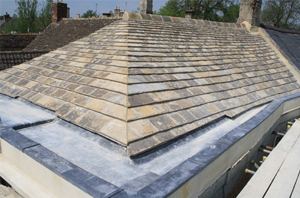Unique roofing material named finalist in roofing awards
 Not far from Stamford in Lincolnshire is Collyweston, a traditional village in the heart of England. It is also the source of Collyweston ‘stone slate’, not a true slate but a fissile limestone formed in the Jurassic period, some 150 million years ago.
Not far from Stamford in Lincolnshire is Collyweston, a traditional village in the heart of England. It is also the source of Collyweston ‘stone slate’, not a true slate but a fissile limestone formed in the Jurassic period, some 150 million years ago.
The stone has been mined in the area since roman times and was used extensively in the local area and on some prominent buildings around the country until the growth of the railways in the late 19th century led to the decline in the quarrying industry.
The process of producing roofing tiles from the stone is unusual in that it involved the slate 'logs' being exposed to frost which causes the slate to split along its veins, producing a stones that are ready for shaping using specially designed hammers. Once worked, the stone slates are stored on their edge for onward sale or for local roofing.
The trade is experiencing a resurgence, not least because the “resilience and long life of the slate ensured that building owners continued to demand the material and hence the craft and a few businesses survive to this day”.
The quality of the stone and its installers is exemplified by local company Claude N Smith, which both owns a mine and installs high-quality roofs. One of the company’s restoration projects in nearby King’s Cliffe has been named by the NFRC as a finalist in the Heritage category of this year’s roofing awards.
For more information go to http://www.claudesmith.co.uk















